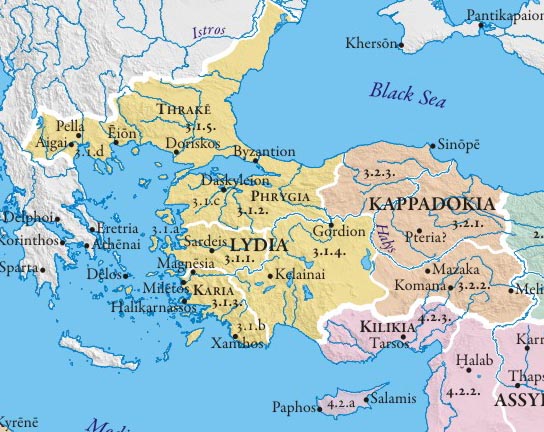Lydia
 Lydia (Lydian: 𐤮𐤱𐤠𐤭𐤣𐤠, Śfarda; Aramaic: Lydia; Greek: Λυδία, Lȳdíā; Turkish: Lidya) was an Iron Age kingdom of western Asia Minor located generally east of ancient Ionia in the modern western Turkish provinces of Uşak, Manisa and inland İzmir. The language of its population, known as Lydian, was a member of the Anatolian branch of the Indo-European language family. Its capital was Sardis.
Lydia (Lydian: 𐤮𐤱𐤠𐤭𐤣𐤠, Śfarda; Aramaic: Lydia; Greek: Λυδία, Lȳdíā; Turkish: Lidya) was an Iron Age kingdom of western Asia Minor located generally east of ancient Ionia in the modern western Turkish provinces of Uşak, Manisa and inland İzmir. The language of its population, known as Lydian, was a member of the Anatolian branch of the Indo-European language family. Its capital was Sardis.
The Kingdom of Lydia existed from about 1200 BC to 546 BC. At its greatest extent, during the 7th century BC, it covered all of western Anatolia. In 546 BC, it became a province of the Achaemenid Persian Empire, known as the satrapy of Lydia or Sparda in Old Persian. In 133 BC, it became part of the Roman province of Asia.
Defining Lydia
The temple of Artemis in Sardis.
Sardis Synagogue.
The endonym Śfard (the name the Lydians called themselves) survives in bilingual and trilingual stone-carved notices of the Achaemenid Empire: the satrapy of Sparda (Old Persian), Saparda, Babylonian Sapardu, Elamitic Išbarda, Hebrew סְפָרַד.[3] These in the Greek tradition are associated with Sardis, the capital city of King Gyges, constructed during the 7th century BC. Lydia is called Kisitan by Hayton of Corycus (in The Flower of the History of the East), a name which was corrupted to Quesiton in The Travels of Sir John Mandeville.
The region of the Lydian kingdom was during the 15th–14th centuries BCE part of the Arzawa kingdom. However, the Lydian language is usually not categorized as part of the Luwic subgroup, unlike the other nearby Anatolian languages Luwian, Carian, and Lycian.[4]
Portrait of Croesus, last King of Lydia, Attic red-figure amphora, painted ca. 500–490 BC.
Tripolis on the Meander is an ancient Lydian city in Turkey.
Tripolis on the Meander is an ancient Lydian city in Turkey.
Geography
Büyük Menderes River also known as Maeander is river in Lydia.
The boundaries of historical Lydia varied across the centuries. It was bounded first by Mysia, Caria, Phrygia and coastal Ionia. Later, the military power of Alyattes and Croesus expanded Lydia, which, with its capital at Sardis, controlled all Asia Minor west of the River Halys, except Lycia. After the Persian conquest the River Maeander was regarded as its southern boundary, and during imperial Roman times Lydia comprised the country between Mysia and Caria on the one side and Phrygia and the Aegean Sea on the other.
Language
The Lydian language was an Indo-European language in the Anatolian language family, related to Luwian and Hittite. Due to its fragmentary attestation, the meanings of many words are unknown but much of the grammar has been determined. Similar to other Anatolian languages, it featured extensive use of prefixes and grammatical particles to chain clauses together.[5] Lydian had also undergone extensive syncope, leading to numerous consonant clusters atypical of Indo-European languages. Lydian finally became extinct during the 1st century BC.
History
Early history: Maeonia and Lydia
Croesus at the stake. Side A from an Attic red-figure amphora, ca. 500–490 BC
Bin Tepe royal funeral tumulus (tomb of Alyattes, father of Croesus), Lydia, 6th century BC.
Tomb of Alyattes.
Lydia developed after the decline of the Hittite Empire in the 12th century BC. In Hittite times, the name for the region had been Arzawa. According to Greek source, the original name of the Lydian kingdom was Maionia (Μαιονία), or Maeonia: Homer (Iliad ii. 865; v. 43, xi. 431) refers to the inhabitants of Lydia as Maiones (Μαίονες).[6] Homer describes their capital not as Sardis but as Hyde (Iliad xx. 385); Hyde may have been the name of the district in which Sardis was located.[7] Later, Herodotus (Histories i. 7) adds that the "Meiones" were renamed Lydians after their king Lydus (Λυδός), son of Atys, during the mythical epoch that preceded the Heracleid dynasty. This etiological eponym served to account for the Greek ethnic name Lydoi (Λυδοί). The Hebrew term for Lydians, Lûḏîm (לודים), as found in the Book of Jeremiah (46.9), has been similarly considered, beginning with Flavius Josephus, to be derived from Lud son of Shem;[8] however, Hippolytus of Rome (234 AD) offered an alternative opinion that the Lydians were descended from Ludim, son of Mizraim. During Biblical times, the Lydian warriors were famous archers. Some Maeones still existed during historical times in the upland interior along the River Hermus, where a town named Maeonia existed, according to Pliny the Elder (Natural History book v:30) and Hierocles (author of Synecdemus).




